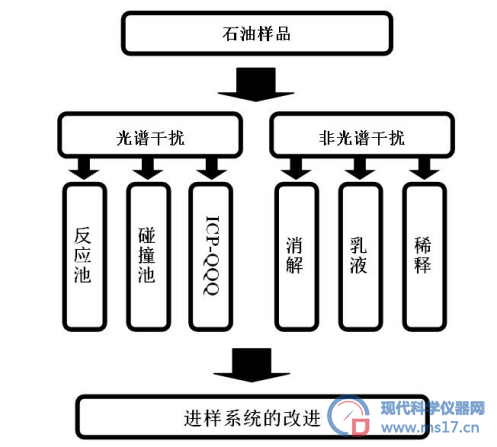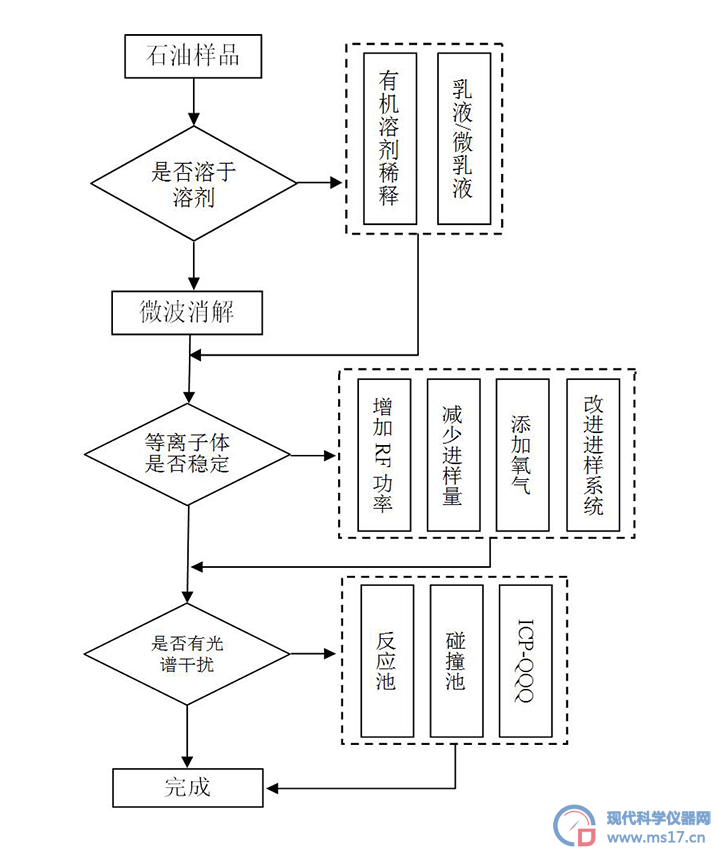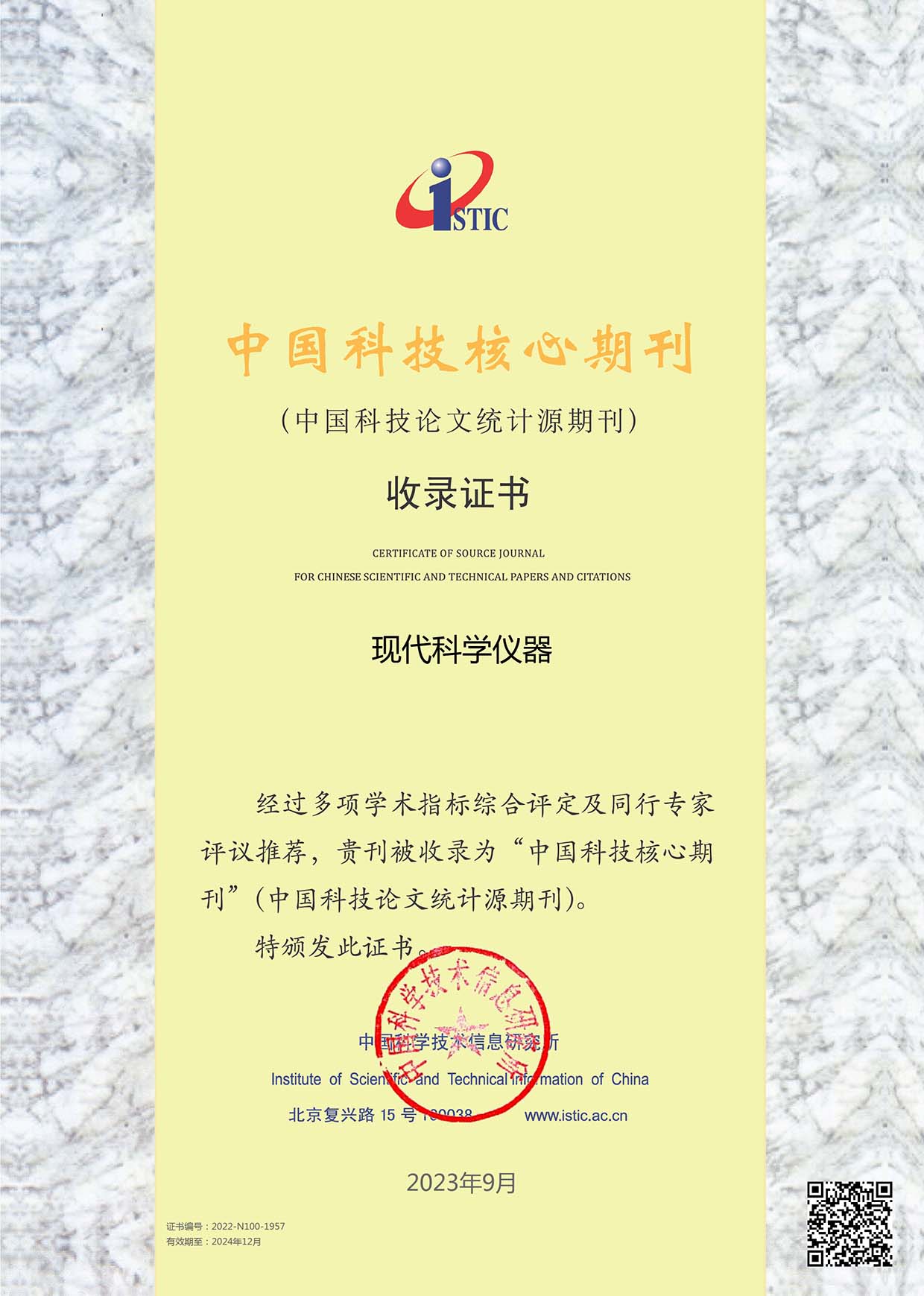ICP-MS方法测定石油及其产品中的微量元素
ICP-MS方法测定石油及其产品中的微量元素
王轲1 褚小立1 杨德凤1 田松柏1
(1.石油化工科学研究院 北京 100083)
摘 要 石油及其产品中的微量元素在工业和环境应用中提供了非常重要的信息,电感耦合等离子质谱(ICP-MS)具有高灵敏度、快速、多元素分析能力因而受到越来越多人的关注。石油产品种类多、基体复杂,物理化学性质差异巨大,如何消除或者抑制各种样品带来的干扰,是ICP-MS分析石油产品的关键。主要的办法是通过池技术消除光谱干扰,通过预处理、乳液和有机溶剂稀释的方法消除基体效应,同时通过对进样系统的改进,可以进一步改善分析性能,降低检出限。随着联用技术的发展,通过与色谱的联用,ICP-MS还可以进行元素的形态分析,这极大的拓展了应用领域,也是一个新的挑战。
关键词 电感耦合等离子质谱;微量元素;石油;联用技术
中图分类号 TE622
Determination of Trace Elements in Petroleum Products by Inductively Coupled Plasma Mass Spectrometry
WANG Ke1 CHU Xiaoli1 YANG Defeng1 TIAN Songbai1
(1. Research Institute of Petroleum Processing, Beijing 100083 China)
Abstract Trace elements in petroleum products can give very important information in industrial and environmental applications. Inductively coupled plasma mass spectrometry (ICP-MS) is highly appropriate to perform this kind of analyses because of its great sensitivity, speediness and multielement analysis ability. Petroleum products are heterogeneous mixture with complex matrix and different chemistry/physical property, so how to overcome the interferences is the key of ICP –MS analysis method. The cell technique is used to overcome spectroscopic interferences and none-spectroscopic interferences are eliminated by pretreatment, emulsion or dilution. The improvement of sample introduction system can optimize performance. The hyphenated technique of chromatography with ICP-MS can analyze element speciation in petroleum products. It extends application field of ICP-MS and brings a new challenge to us.
Key words inductively coupled plasma mass spectrometry; trace elements;petroleum; hyphenated technique
石油是一种由碳氢化合物为主要成分的复杂的混合物,但石油产品中的微量元素也在石化生产和使用过程中扮演着重要的角色[1],例如原油中的As会在石油炼制过程中对催化剂产生不良影响[2],Ni、V和Pb等元素可以作为原油的指纹信息,对于原油的形成以及石油泄漏的追责方面提供有力的参考[3],汽油中的Mn、Si、S等元素会对发动机造成损害,其排放的废气还会污染空气[4]。因此,对石油产品中微量元素测定是非常重要的。现在有许多分析方法在石化领域进行应用,常见的有原子吸收光谱法(AAS)、电感耦合等离子发射光谱法(ICP-OES)、波长色散X射线荧光光谱法(XRF)等[5]。随着石化产业的升级以及日益严格的环保法规的要求,对于元素含量的分析要求朝着低含量、快速、稳定的方向发展,电感耦合等离子质谱(ICP-MS)作为一种具有极高分辨率和多元素分析能力的仪器分析技术被越来越多的人关注。
由于ICP-MS分析中消除干扰极为重要,因此本文以如何消除分析中遇到的干扰为主线,介绍近年来ICP-MS在石油领域的研究和应用进展。随着与色谱联用技术的发展,使ICP-MS具有形态分析能力,极大的拓展了应用范围,可以提供更多有用的信息,这也是最近的研究热点,本文也将在最后对此进行概述。
1 ICP-MS分析技术的研究与应用
ICP-MS具有极高的分辨率、优秀的稳定性和多元素快速分析能力,被认为是最有力的元素分析仪器之一。然而,光谱干扰和非光谱干扰对ICP-MS的分析会造成严重影响,光谱干扰包括电离产生和同量异位素和离子之间或离子-分子反应生成的多原子离子干扰等。非光谱干扰包括基体效应等,而石油样品又具有基体复杂、有机物含量高的特点,几乎所有在石油领域的应用都要同时应用多种方法对两种干扰进行消除(图1),尤其以消除光谱干扰最为关键,接下来将分别对不同干扰消除方式分类分别进行介绍。

图1 干扰消除方法
1.1 ICP-MS光谱干扰消除技术
自从1980年首次报道以来,光谱干扰一直是限制ICP-MS应用的一个主要因素,其中同量异位素和多原子离子干扰是一种重要的干扰,例如40Ca+、28P+、32S+会分别被40Ar+、14N2+、16O2+干扰,这会严重影响这些元素分析的灵敏度和准确性,甚至无法进行定量分析,而这些元素又是石油和石油产品中的重点关注的元素,因此,如何消除这些干扰是ICP-MS分析中最重要的挑战。
碰撞/反应池技术出现后,由于其优异的去干扰能力受到了人们的广泛关注和快速发展。该技术是通过在质量检测器前增加四/六/八极杆作为碰撞/反应池,在其中加入特别的气体与干扰离子进行碰撞/反应从而消除干扰。为达到有效消除干扰的目的,需要同时消除从等离子体和溶剂中带来的干扰离子和在池中生成的离子,其中反应气可以消除前者,后者主要有三种不同的池技术来实现:1)动态反应池(DRC)技术[6],该技术是通过四极杆的通带过滤将不需要的低质量数离子驱逐出去,从而避免了与反应气分子生成新的干扰离子;2)ICP-QQQ[7],即在反应池前增加一个四极杆质量过滤器,只允许待测离子和相同质荷比的干扰离子进入反应池,从而避免了副反应生成新的干扰;3)动能歧视(KED)技术[8],该技术利用经过碰撞或反应的干扰离子比待测离子具有较低的动能的特点,通过调节四极杆偏转电压来设定一个合适的势垒来阻挡低动能的干扰离子进入质量分析器,从而达到消除干扰的目的。
这三种池技术各有特点,其中动态反应池技术应用最为广泛,采用甲烷为反应气,可以消除Ca、Mg、Fe、Cr的干扰,使检出限达到ppb级别[9],用氢气做反应气,可以消除Si的干扰[10],而当干扰物不易消除时,还可以通过反应气与待测元素反应,生成一种干扰较小的多原子离子进行分析,例如用氧气为反应气,将存在巨大干扰的S、P氧化成SO+和PO+,从而实现定量分析[11,12]。通过选择合适的反应气和通带过滤条件,理论上可以消除所有的同质异构干扰,但是由于反应复杂以及副反应可能会生成新的干扰物,所以需要不断研究开发新的反应条件以优化干扰消除效果。ICP-QQQ技术作为一项新报道的技术,实际上是动态反应池的另一种实现形式,现有的报道还不多,仅有关于S、P、Si的分析报道[7,13,14],通过反应池前的质量筛选避免了副反应的产生,从而降低了检出限。而动能歧视技术和上述两者有显著区别,主要是通过气体与干扰离子碰撞以及离子间反应造成的动能降低使待测离子和干扰物分离,不会有副反应发生,也就不用考虑生成新干扰物的问题,对于中等质量数元素(如Ni、V、Mo、Cu等)有着很好效果[15,16],但由于碰撞的随机性和合适的势垒选择难度,KED模式会造成信号值大幅降低,可能会对灵敏度造成影响,这就对其应用造成来限制。
1.2 非光谱干扰消除技术
非光谱干扰主要是指样品雾化和进入等离子体的过程中,由于样品的物理性质的差异造成的干扰,对于最为常用的外标法来说,就是样品和标准物质之间的差异,例如挥发性、粘度、溶解度等。另外,石油样品作为一种复杂的有机物,具有很强的基体效应,这些都是分析中必须克服的。
1.2.1 消解法
ICP-MS最初是设计分析水溶液样品的仪器,因此,将样品通过消解的方法从有机物变成无机物,再用酸溶于水中就可以解决样品的基体效应带来的影响,而且对于重油和渣油这也是最有效的预处理手段。最常见的消解方法是敞口灰化法[17],将样品加热点燃,通过燃烧去除有机物,再放入马弗炉内高温去除残碳,最后用酸溶解,但是该方法需要的样品量大,加热过程中会造成元素损失。为克服这些问题,通过密闭容器、采用酸消解的方法可以减少元素的挥发[18]。用微波代替电阻炉,可以实现更有效率的燃烧[19,20],不但可以分析常见的金属元素,还可以对易挥发的卤素和S含量进行测定。微波辅助-酸消解也是一种有效的样品消解手段,由于其具有需要样品量少,密闭消解防止元素损失和污染,反应时间快等优点被广泛使用于原油及各馏分的石油产品中[21-24],为了达到更好的消解效果,尤其是对一些残碳含量高的样品,可以通过电热灰化后再进行微波消解[25],或者在消解罐中加入紫外灯,通过紫外光辅助微波消解从而实现去除残碳的目的[26]。
1.2.2 有机溶剂稀释法
选用合适的溶剂稀释后直接进样分析也是一种常见的分析方法,常用的溶剂有甲苯、二甲苯、煤油、甲基异丁基戊酮等[8],例如二甲苯被广泛应用于原油中微量元素的分析[15,27,28],煤油用作生物柴油的稀释剂[29]等。由于各种样品的挥发性、粘度等性质不同,因此需要合适的稀释倍数来减少基体效应,一般认为稀释10倍可以有效减少基体差异,对于易挥发的汽油、石脑油等样品,可以将稀释倍数增加到100倍[30]。采用标准加入法可以进一步减少基体效应[28]。大量的有机物进入等离子体,会导致等离子体不稳定、积碳等问题,这就需要通过加大射频(RF)功率,加入氧气等手段来缓解[31,32]。虽然有机直接进样会增大基体效应,电离出的大量碳氢离子发生反应产生严重的光谱干扰[33],但是由于有机物粘度比水小、挥发性大,会有更多的样品进入等离子体,这对于一些难电离的元素,例如Se,溶液中的有机物会增大信号强度[34,35],而活泼的碳氢离子虽然会发生很多副反应,但是有时这种反应却可以阻止一些干扰物的产生,例如As的主要干扰物是AsCl+,当有机物存在时,Cl-更容易和碳氢离子反应,阻止AsCl+的生成,从而减少了干扰[36]。
1.2.3 乳液法
乳液是在水中加入油和表面活性剂制备的油水混合体系,其本质上是另一种稀释的方法,但是由于乳液中有机物含量相对较低,因此对等离子体的负荷也较小,产生的干扰也相应较少,还可以使用水溶液标样建立标准曲线,这可以减少分析成本,同时也减少有机废液量,降低环境负荷[37-39]。微乳液是加入更多的乳化剂形成的乳液,虽然有机物含量增加了,但是溶液更加稳定,检出限也更低[40],在原油[41]、汽柴油[42]中都有应用。除了常见的表面活性剂外,酸也能作为介质制备乳液[43],进一步降低了溶液中的有机物含量,使分析更加容易。另外,还有学者采用先制备乳液,再用离心等方法破乳,将油中的待测元素转移到水溶液中,从而避免了有机物的干扰[44,45]。
1.3 进样系统的优化
除了上述消除光谱和非光谱干扰的方法外,对进样系统的改进也可以有效地改善分析性能。对于汽油、石脑油这类易挥发的轻质油品,如果直接进样会因为样品挥发性太强使得等离子体瞬间需要的能量过高而造成熄灭,因此一般采用微流量雾化器和制冷雾室进样的办法[46]减少进样量,从而实现样品的分析。超声波雾化器(USN)可以将样品雾化效率显著提高,从而减少了溶剂进入等离子体的比例,降低了基体对等离子体的影响,对于汽油这种轻质油品[46]以及原油这样基体复杂的油品[47]都能获得很好的分析结果。加热矩管整合进样系统(h-TISIS)是另外一种进样系统,其最大特点就是不产生废液,具有死体积小,灵敏度高和非光谱干扰少等优点,特别适合轻质油品的分析[33],通过减小雾化器毛细管直径,还可以实现样品不稀释直接进样[48]。
近年来,低样品消耗量的进样系统越来越吸引人们的目光,主要包括直接注入雾化器(DIN)[49]和直接注入高效雾化器(DIHEN)[50]等。它们不用雾室,气溶胶在离等离子体4-5mm处生成,与传统进样系统相比,直接注入雾化器具有样品消耗量少,传输效率高,等离子体的负荷小,记忆效应小等优势[51],因此特别适合油品的分析,尤其是对于轻质油品,传统的用制冷雾室降低样品进样量的方式会降低信号强度,而DIN不用制冷,样品1:1稀释后即可直接进样分析,使得检出限较传统进样系统的低[52]。而DIHEN比DIN成本低且更加易用,不需要高压泵来获得合适的液体流速,因而有更广泛的应用[53,54]。
2 色谱与ICP-MS联用技术的研究与应用
色谱可以通过沸点差异、极性强弱或者分子大小将不同形态的化合物分离,而ICP-MS具有分辨率高、多元素分析能力,特别适合作为色谱的检测器,尤其是对于石油中金属元素化合物的分析有着广泛的应用[55]。
2.1 LC(GPC)-ICP-MS
色谱与ICP-MS联用的关键在于接口技术,由于液相色谱(LC)的流出液的流速与ICP-MS的进样速率相匹配,因此只要将流出液直接引入雾化器即可进行分析,因此是最早应用的联用技术,在对油品中的S、Se以及卤素等元素的化合物分析都有大量的报道[56,57]。凝胶色谱(GPC)是一类特殊的液相色谱,它是通过分子大小的不同来分离不同的化合物,可以对原油不同馏分中中的Ni、V和S的分子量分布进行测定[58],为原油评价提供了重要的信息。固定床渣油脱硫(RDS)是一个重要的催化反应,它可以生产低硫燃料油以及给渣油催化裂化装置提供原料,对不同催化剂的RDS流出物中的S和V分子量分布进行分析,可以评价催化反应的效果,对于更好的理解RDS反应的机理和工艺的改进提供了有用的信息[59]。
2.2 GC-ICP-MS
气相色谱(GC)在石油领域有着广泛的应用,通过与ICP-MS的联用可以实现气体中化合物的半定量和定量分析[60-62]。随着接口技术的发展,商用恒温接口的出现可以保证馏出物进入等离子体而不会凝结[63],极大的推动了GC-ICP-MS的应用。由于经过色谱分离的气体形态单一,与液体进样相比减少了溶剂对分析的干扰,例如S可以不用氧气做反应气而直接测定[56]。原油中的汞是一种有毒元素,对石油炼制和环境都会造成毒害,通过分析原油中汞的形态以及不同馏分中的分布,可以对更好的脱汞提供帮助,并且与传统的GC-MS和GC-pyro-AFS方法相比,GC-ICP-MS的检出限更低 [64-66]。原油中的Ni、V含量是原油重要的指纹信息,而对其形态的分析,可以更好的理解原油的起源和形成机理[67]。硅在石油炼制中主要通过消泡剂的形式加入,但在燃料油中混入的硅却会对发动机造成损害,通过对硅形态的分析,可以得知硅在整个炼制过程中的变化,对如何避免硅进入石油产品中以及更好的去除硅提供了重要的参考[10,68,69]。除此之外,对淤泥中的有毒化合物以及原油和废水中的卤素化合物的测定[70,71],也都有报道。
3 结束语
石油产品的微量元素分析在石化工业和环境保护中有重要的价值,因此一直受到人们的重视,而ICP-MS的高灵敏度、高稳定性和多元素分析能力的特点,使其是一种重要的分析工具。对于某一特定的石油样品而言,开发其分析方法主要是如何干扰消除,图2归纳出了采用多种去干扰技术对石油样品的分析实例,包括用池技术(DRC、ICP-QQQ、KED)消除光谱干扰,以及采用消解、有机溶剂稀释、乳液法消除非光谱干扰,还有进样系统的改进。

图2 建立ICP-MS分析方法的步骤
通过这些手段使干扰得到有效的消除或抑制,极大的降低了检出限,改善了分析性能。而与色谱的联用极大的拓展了ICP-MS的应用范围,使其具备了形态分析能力,这对更好的理解原油的性质以及炼化过程中的反应机理提供了许多有用的信息。
总之,经过数十年来众多学者的研究和改进,ICP-MS已经逐步从一种昂贵、特殊需要的分析仪器变成了一种新兴的常规分析手段。因此,对ICP-MS以及联用技术的研究,无论从分析技术还是工业应用上来说都具有重要的科研价值和现实意义。
参考文献
[1] Lienemann CP. Analysis of trace metals in petroleum products, state of the art[J]. Oil & Gas Science And Technology-Revue D Ifp Energies Nouvelles, 2005, 60(6): 951-965
[2] Wilson SC, Lockwood PV, Ashley PM,et al. The chemistry and behaviour of antimony in the soil environment with comparisons to arsenic: A critical review[J]. Environmental Pollution, 2010, 158(5): 1169-1181
[3] Gottikh RP, Pisotsky BI, Zhuravlev DZ. Geochemical properties of oils in different regions and potential source metals contained in oil[J]. Doklady Earth Sciences, 2008, 422(1): 1084-1088
[4] KORN M, SANTOS D, WELZ B,et al. Atomic spectrometric methods for the determination of metals and metalloids in automotive fuels – A review[J]. Talanta, 2007, 73(1): 1-11
[5] AMORIM F, WELZ B, COSTA A,et al. Determination of vanadium in petroleum and petroleum products using atomic spectrometric techniques[J]. Talanta, 2007, 72(2): 349-35
[6] Tanner SD, Baranov VI, Bandura DR. Reaction cells and collision cells for ICP-MS: a tutorial review[J]. Spectrochimica Acta Part B: Atomic Spectroscopy, 2002, 57(9): 1361-1452
[7] Fernández SD, Sugishama N, Encinar JR,et al. Triple Quad ICPMS (ICPQQQ) as a New Tool for Absolute Quantitative Proteomics and Phosphoproteomics[J]. Analytical Chemistry, 2012, 84(14): 5851-5857
[8] Yamada N. Kinetic energy discrimination in collision/reaction cell ICP-MS: Theoretical review of principles and limitations[J]. Spectrochimica Acta Part B: Atomic Spectroscopy, 2015, 110: 31-44
[9] de Souza JR, Duyck CB, Fonseca TCO,et al. Multielemental determination in oil matrices diluted in xylene by ICP-MS with a dynamic reaction cell employing methane as reaction gas for solving specific interferences[J]. Journal of Analytical Atomic Spectrometry, 2012, 27(8): 1280-1286
[10] Chainet F, Lienemann C, Ponthus J,et al. Towards silicon speciation in light petroleum products using gas chromatography coupled to inductively coupled plasma mass spectrometry equipped with a dynamic reaction cell[J]. Spectrochimica Acta Part B: Atomic Spectroscopy, 2014, 97: 49-56
[11] Bandura DR, Baranov VI, Tanner SD. Detection of Ultratrace Phosphorus and Sulfur by Quadrupole ICPMS with Dynamic Reaction Cell[J]. Analytical Chemistry, 2002, 74(7): 1497-1502
[12] Donati GL, Amais RS, Nobrega JA. Interference standard and oxide ion detection as strategies to determine phosphorus and sulfur in fuel samples by inductively coupled plasma quadrupole mass spectrometry[J]. Journal of Analytical Atomic Spectrometry, 2012, 27(8): 1274-1279
[13] Balcaen L, Woods G, Resano M,et al. Accurate determination of S in organic matrices using isotope dilution ICP-MS/MS[J]. J. Anal. At. Spectrom., 2013, 28(1): 33-39
[14] Amais RS, Amaral CDB, Fialho LL,et al. Determination of P, S and Si in biodiesel, diesel and lubricating oil using ICP-MS/MS[J]. Analytical Methods, 2014, 6(13): 4516-4520
[15] Dreyfus S, Pécheyran C, Magnier C,et al.Direct trace and ultra-trace metals determination in crude oil and fractions by inductively coupled plasma mass spectrometry[C].Elemental Analysis of Fuels and Lubricants: Recent Advances and Future Prospects.Tampa, FL:American Society for Testing and Materials,2005.51-58
[16] Giusti P, Ordóñez Y N, Lienemann C P, et al. μFlow-injection–ICP collision cell MS determination of molybdenum, nickel and vanadium in petroleum samples using a modified total consumption micronebulizer[J]. J. Anal. At. Spectrom., 2007, 22(1): 88-92
[17] Kowalewska Z, Ruszczyńska A, Bulska E. Cu determination in crude oil distillation products by atomic absorption and inductively coupled plasma mass spectrometry after analyte transfer to aqueous solution[J]. Spectrochimica Acta Part B: Atomic Spectroscopy, 2005, 60(3): 351-359
[18] Magdziarz A, Dalai AK, Koziński JA. Chemical composition, character and reactivity of renewable fuel ashes[J]. Fuel, 2016, 176: 135-145
[19] Pereira JSF, Moraes DP, Antes FG,et al. Determination of metals and metalloids in light and heavy crude oil by ICP-MS after digestion by microwave-induced combustion[J]. Microchemical Journal, 2010, 96(1): 4-11
[20] Pereira LSF, Frohlich AC, Duarte FA,et al. Determination of halogens and sulfur in pitch from crude oil by plasma-based techniques after microwave-induced combustion[J]. Journal of Analytical Atomic Spectrometry, 2015, 30(8): 1822-1827
[21] Duyck C, Miekeley N, da Silveira C L P, et al. The determination of trace elements in crude oil and its heavy fractions by atomic spectrometry[J]. Spectrochimica Acta Part B: Atomic Spectroscopy, 2007, 62(9): 939-95
[22] Xie H, Huang K, Liu J,et al. Determination of trace elements in residual oil by high-resolution inductively coupled plasma mass spectrometry[J]. Analytical and Bioanalytical Chemistry, 2009, 393(8): 2075-2080
[23] Bettinelli M, Spezia S, Baroni U, et al. Determination of Trace Elements in Fuel Oils by Inductively Coupled Plasma Mass Spectrometry after Acid Mineralization of the Sample in a Microwave Oven[J]. Journal of Analytical Atomic Spectrometry, 1995, 10(8): 555-560
[24] Pillay AE, Elkadi M, Fok SC,et al. A comparison of trace metal profiles of neem biodiesel and commercial biofuels using high performance ICP-MS[J]. Fuel, 2012, 97: 385-389
[25] Balarama Krishna MV, Chandrasekaran K, Chakravarthy S,et al. An integrated approach based on oxidative pyrolysis and microwave-assisted digestion for the multi-elemental analysis of coal samples by ICP-based techniques[J]. Fuel, 2015, 158: 770-778
[26] Pereira JSF, Picoloto RS, Pereira LSF,et al. High-Efficiency Microwave-Assisted Digestion Combined to in Situ Ultraviolet Radiation for the Determination of Rare Earth Elements by Ultrasonic Nebulization ICPMS in Crude Oils[J]. Analytical Chemistry, 2013, 85(22): 11034-11040
[27] de Albuquerque FI, Duyck CB, Fonseca TCO,et al. Determination of As and Se in crude oil diluted in xylene by inductively coupled plasma mass spectrometry using a dynamic reaction cell for interference correction on 80Se[J]. Spectrochimica Acta Part B: Atomic Spectroscopy, 2012, 71-72: 112-116
[28] Dreyfus S, Pecheyran C, Magnier C, et al. Direct trace and ultra-trace metals determination in crude oil and fractions by inductively coupled plasma mass spectrometry[J]. Journal of ASTM International, 2005, 2(9):1-8
[29] Woods G D, Fryer F I. Direct elemental analysis of biodiesel by inductively coupled plasma--mass spectrometry[J]. Analytical and Bioanalytical Chemistry, 2007, 389(3): 753-761
[30] Sánchez R, Todolí JL, Lienemann C,et al. Determination of trace elements in petroleum products by inductively coupled plasma techniques: A critical review[J]. Spectrochimica Acta Part B: Atomic Spectroscopy, 2013, 88: 104-126
[31] Leclercq A, Nonell A, Torró J L T, et al. Introduction of organic/hydro-organic matrices in inductively coupled plasma optical emission spectrometry and mass spectrometry: A tutorial review. Part I. Theoretical considerations[J]. Analytica Chimica Acta, 2015, 885: 33-56
[32] Dos Santos EJ, Herrmann AB, Chaves ES,et al. Simultaneous determination of Ca, P, Mg, K and Na in biodiesel by axial view inductively coupled plasma optical emission spectrometry with internal standardization after multivariate optimization[J]. Journal of Analytical Atomic Spectrometry, 2007, 22(10): 1300
[33] Leclercq A, Nonell A, Torró J L T,et al. Introduction of organic/hydro-organic matrices in inductively coupled plasma optical emission spectrometry and mass spectrometry: A tutorial review. Part II. Practical considerations[J]. Analytica Chimica Acta, 2015, 885: 57-91
[34] Olivas RM, Quétel CR, Donard OFX. Sensitive determination of selenium by inductively coupled plasma mass spectrometry with flow injection and hydride generation in the presence of organic solvents[J]. J. Anal. At. Spectrom., 1995, 10(10): 865-870
[35] Goossens J, Vanhaecke F, Moens L,et al. Elimination of interferences in the determination of arsenic and selenium in biological samples by inductively coupled plasma mass spectrometry[J]. Analytica Chimica Acta, 1993, 280(1): 137-143
[36] Larsen EH, Sturup S. Carbon-enhanced inductively coupled plasma mass spectrometric detection of arsenic and selenium and its application to arsenic speciation[J]. Journal of Analytical Atomic Spectrometry, 1994, 9(10): 1099-1105
[37] Kumar S J, Gangadharan S. Determination of trace elements in naphtha by inductively coupled plasma mass spectrometry using water-in-oil emulsions[J]. Journal of Analytical Atomic Spectrometry, 1999, 14(5): 967-971
[38] BURGUERA J. Analytical applications of organized assemblies for on-line spectrometric determinations: present and future[J]. Talanta, 2004, 64(5): 1099-1108
[39] Saint'Pierre TD, Dias LF, Maia SM,et al. Determination of Cd, Cu, Fe, Pb and Tl in gasoline as emulsion by electrothermal vaporization inductively coupled plasma mass spectrometry with analyte addition and isotope dilution calibration techniques[J]. Spectrochimica Acta Part B: Atomic Spectroscopy, 2004, 59(4): 551-558
[40] Lord CJ. Determination of trace metals in crude oil by inductively coupled plasma mass spectrometry with microemulsion sample introduction[J]. Analytical Chemistry, 1991, 63(15): 1594-1599
[41] Al-Swaidan HM. The determination of lead, nickel and vanadium in Saudi Arabian crude oil by sequential injection analysis/inductively-coupled plasma mass spectrometry[J]. Talanta, 1996, 43(8): 1313-1319
[42] Santelli RE, Oliveira EP, de Carvalho MDFB,et al. Total sulfur determination in gasoline, kerosene and diesel fuel using inductively coupled plasma optical emission spectrometry after direct sample introduction as detergent emulsions[J]. Spectrochimica Acta Part B: Atomic Spectroscopy, 2008, 63(7): 800-804
[43] Thiem TL, Watson JD. Extraction Efficiencies of Emulsions for 21 Elements in Oil and Transmission Fluids by Inductively Coupled Plasma Spectroscopy[J]. Microchemical Journal, 1997, 57(2): 245-250
[44] Cassella RJ, Brum DM, Robaina NF,et al. Extraction induced by emulsion breaking for metals determination in diesel oil by ICP-MS[J]. J. Anal. At. Spectrom., 2012, 27(2): 364-370
[45] He Y, Ling Z, Zhou Y,et al. Application of extraction induced by emulsion breaking for trace multi-element determination in jet fuel by inductively coupled plasma-mass spectrometry[J]. Spectroscopy Letters, 2016, 49(1): 37-43
[46] Lienemann CP, Dreyfus S, Pecheyran C,et al. Trace metal Analysis in Petroleum Products: Sample Introduction evaluation in ICP-OES and Comparison with an ICP-MS Approach[J]. Oil & Gas Science and Technology - Revue de l'IFP, 2007, 62(1): 69-77
[47] Dreyfus S, Pécheyran C, Lienemann CP,et al. Determination of lead isotope ratios in crude oils with Q-ICP/MS[J]. J. Anal. At. Spectrom., 2007, 22(4): 351-360
[48] Caumette G, Lienemann C, Merdrignac I,et al. Sensitivity improvement in ICP MS analysis of fuels and light petroleum matrices using a microflow nebulizer and heated spray chamber sample introduction[J]. Talanta, 2009, 80(2): 1039-1043
[49] Crain J S, Kiely J T. Waste Reduction in Inductively Coupled Plasma Mass Spectrometry Using Flow Injection and a Direct Injection Nebulizer[J]. Journal of Analytical Atomic Spectrometry, 1996, 11: 525-527
[50] McLean JA, Zhang H, Montaser A. A Direct Injection High-Efficiency Nebulizer for Inductively Coupled Plasma Mass Spectrometry[J]. Analytical Chemistry, 1998, 70(5): 1012-1020
[51] Todolí JL, Mermet JM. Sample introduction systems for the analysis of liquid microsamples by ICP-AES and ICP-MS[J]. Spectrochimica Acta Part B: Atomic Spectroscopy, 2006, 61(3): 239-283
[52] Botto RI. Trace element analysis of petroleum naphthas and tars using direct injection ICP-MS[J]. Canadian Journal of Analytical Sciences and Spectroscopy, 2002, 47(1): 1-13
[53] Kahen K, Strubinger A, Chirinos JR,et al. Direct injection high efficiency nebulizer-inductively coupled plasma mass spectrometry for analysis of petroleum samples[J]. Spectrochimica Acta Part B: Atomic Spectroscopy, 2003, 58(3): 397-413
[54] Heilmann J, Boulyga SF, Heumann KG. Accurate determination of sulfur in gasoline and related fuel samples using isotope dilution ICP–MS with direct sample injection and microwave-assisted digestion[J]. Analytical and Bioanalytical Chemistry, 2004, 380(2): 190-197
[55] Caumette G, Lienemann C, Merdrignac I,et al. Element speciation analysis of petroleum and related materials[J]. Journal of Analytical Atomic Spectrometry, 2009, 24(3): 263
[56] Martínez-Sierra J G, San Blas O G, Gayón J M M,et al. Sulfur analysis by inductively coupled plasma-mass spectrometry: A review[J]. Spectrochimica Acta Part B: Atomic Spectroscopy, 2015, 108: 35-52
[57] Wuilloud JCA, Wuilloud RG, Vonderheide AP,et al. Gas chromatography/plasma spectrometry—an important analytical tool for elemental speciation studies[J]. Spectrochimica Acta Part B: Atomic Spectroscopy, 2004, 59(6): 755-792
[58] Desprez A, Bouyssiere B, Arnaudguilhem C,et al. Study of the Size Distribution of Sulfur, Vanadium, and Nickel Compounds in Four Crude Oils and Their Distillation Cuts by Gel Permeation Chromatography Inductively Coupled Plasma High-Resolution Mass Spectrometry[J]. Energy & Fuels, 2014, 28(6): 3730-3737
[59] Barbier J, Lienemann C, Le Masle A,et al. New Insights into Resid Desulfurization Processes: Molecular Size Dependence of Catalytic Performances Quantified by Size Exclusion Chromatography-ICP/MS[J]. Energy & Fuels, 2013, 27(11): 6567-6574
[60] Carter KE, Gerdes K. A method for direct, semi-quantitative analysis of gas phase samples using gas chromatography–inductively coupled plasma-mass spectrometry[J]. Spectrochimica Acta Part B: Atomic Spectroscopy, 2013, 85: 34-44
[61] 宋阳, 张颖, 魏新宇,等. GC–ICP–MS法测定丙烯中的痕量砷化氢[J]. 化学分析计量, 2014, 3: 39-42
[62] 宋阳, 张颖, 魏新宇,等. 使用GC-ICP-MS法快速测定乙烯中的痕量磷化氢[J]. 石化技术与应用, 2014, 4: 350-354
[63] Bouyssiere B, Szpunar J, Lobinski R. Gas chromatography with inductively coupled plasma mass spectrometric detection in speciation analysis[J]. Spectrochimica Acta Part B: Atomic Spectroscopy, 2002, 57(5): 805-828
[64] Bouyssiere1 B, Baco F, Savary L. Analytical Methods for Speciation of Mercury in Gas Condensates[J]. Oil & Gas Science and Technology, 2000, 55(6): 639-648
[65] Nevado JJ, Martin-Doimeadios RC, Krupp EM,et al. Comparison of gas chromatographic hyphenated techniques for mercury speciation analysis[J]. Journal of Chromatography A, 2011, 1218(28): 4545-4551
[66] Pontes FVM, Carneiro MC, Vaitsman DS,et al. Investigation of the Grignard reaction and experimental conditions for the determination of inorganic mercury and methylmercury in crude oils by GC–ICP-MS[J]. Fuel, 2014, 116: 421-426
[67] Ellis J, Rechsteiner C, Moir M,et al. Determination of volatile nickel and vanadinum species in crude oil and crude oil fractions by gas chromatography coupled to inductively coupled plasma mass spectrometry[J]. Journal of Analytical Atomic Spectrometry, 2011, 26(8): 1674
[68] Chainet F, Courtiade M, Lienemann C,et al. Silicon speciation by gas chromatography coupled to mass spectrometry in gasolines[J]. Journal of Chromatography A, 2011, 1218(51): 9269-9278
[69] Chainet F, Lienemann C, Courtiade M,et al. Silicon speciation by hyphenated techniques for environmental, biological and industrial issues: A review[J]. J. Anal. At. Spectrom., 2011, 26(1): 30-51
[70] Li C, Long Z, Jiang X,et al. Atomic spectrometric detectors for gas chromatography[J]. TrAC Trends in Analytical Chemistry, 2016, 77: 139-155
[71] Novak P, Zuliani T, Milačič R,et al. Development of an analytical method for the determination of polybrominated diphenyl ethers in sewage sludge by the use of gas chromatography coupled to inductively coupled plasma mass spectrometry[J]. Analytica Chimica Acta, 2016, 915: 27-35

关注本网官方微信 随时订阅权威资讯

